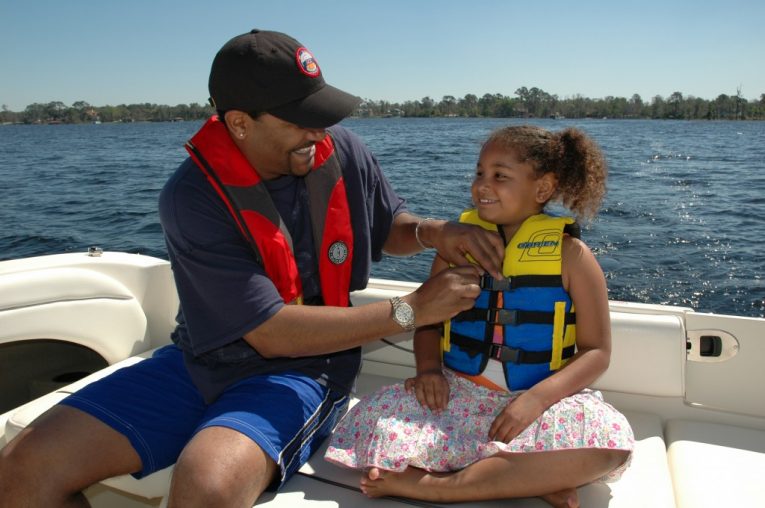It is just as important to wear a life jacket as it is for you to wear a seatbelt when in a car.
Life Jackets and the Law
If you are operating a boat, canoe or kayak of any length, you must carry a U.S. Coast Guard-approved life jacket for each person on board. If stored, they should be readily accessible.
Children under 13 years of age must wear a properly fitted, U.S. Coast Guard-approved life jacket while underway in a boat.
What to know before buying a Life Jacket:
• Life jackets are also called Personal Flotation Devices (PFD’s).
• Unless the life jacket is U.S. Coast Guard-approved, you cannot be sure that it will keep you afloat.
• Add a whistle to your life jacket so that you can blow it if you need help.
• Select the right life jacket for the type of boating and/or activities you will be doing.
• Check that the life jacket is appropriate for your weight and chest size.
• Check that it is properly fitted and fully clipped or zipped up.
• Check for a snug fit. Adjust straps and buckles to ensure a proper fit that does not restrict breathing. If you lift a partner’s life jacket by the shoulders, the life jacket should not ride up to cover the wearer’s ears. Readjust the straps and buckles, and if it still does not pass the lift test, try a different size.
Types of Life Jackets
All life jackets should be U.S. approved, appropriate for your size, fit snugly and be the correct type.
Select the right life jacket for the type of boating and/or activities you will be doing.
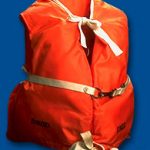 TYPE I (Off-Shore)
TYPE I (Off-Shore)
Good for open, rough or remote water, where rescue may be slow in coming. Although permissible, a Type I life jacket may be too constrictive for paddling.
• Floats Best.
• Turns most unconscious wearer face up in water.
• Highly visible color.
• Bulky.
SIZES: Only two sizes to fit most children and adults.
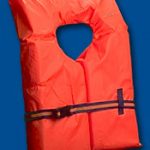 TYPE II (Near-Shore, Buoyant)
TYPE II (Near-Shore, Buoyant)
Good for calm inland water or where there is a good chance of a fast rescue.
• Turns many but not all unconscious wearers face up in water.
• Less bulky, more comfortable than Type I.
• Not for long hours in rough water.
• Will not turn some unconscious wearers face up in the water.
SIZES: Infant, Child-Small, Child-Medium, Adult.
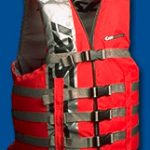 TYPE III (Floatation Aid)
TYPE III (Floatation Aid)
Good for calm inland water or where there is a good chance of a fast rescue.
• Generally the most comfortable for continuous wear because of the freedom of movement.
• Not for long hours in rough water.
• Wearer may have to tilt head back to avoid face-down position in the water.
SIZES: Many individual sizes from Child-Small to Adult.
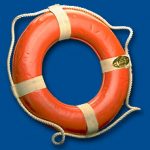 TYPE IV (Throwable Device)
TYPE IV (Throwable Device)
In addition to a wearable life jacket for each person on board, you must have a throwable PFD on board if your boat is 16 ft. or more in length.
Good for calm inland water with heavy boat traffic, where help is always nearby.
• Not for unconscious persons.
• Not for non-swimmers or children.
• Not good for many hours in rough water.
TYPES: Cushions, rings and horse shoe buoys.
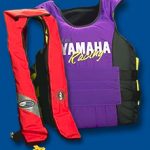 TYPE V (Special Use Device)
TYPE V (Special Use Device)
Must be used for approved activities only.
(See label for limits and use)
VARIETIES: Include vests for sailboarding and rafting, deck suits, work vests, hybrid PFDs and others.
This article is brought to you by the Nashville Boat Club, a private, members-only Boating Country Club® with a fleet of new upscale boats. These meticulously maintained boats are for the exclusive use of members and members have unlimited use of the boats; plus complimentary wakeboards, skis, kneeboards, tubes, and more for you and your family to
enjoy!

